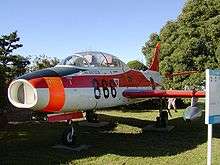Fuji T-1
The Fuji T-1 was Japan's first jet-powered trainer aircraft. The first flight was in January 1958. A total of 66 T-1 planes were built.[1] It was retired in March 2006.
| T-1 | |
|---|---|
.jpg) | |
| T-1B in special paint scheme | |
| Role | Intermediate trainer aircraft |
| Manufacturer | Fuji Heavy Industries |
| First flight | January 1958 |
| Number built | 66 |
Design and development
The T-1 was the first indigenously designed Japanese jet aircraft to be developed since World War II. The T-1A was powered by the British-designed Bristol Siddeley Orpheus turbojet,[2] while the T-1B used the Ishikawajima-Harima J3 turbojet.[3] Fuji was the successor to the Nakajima Aircraft Company (famous for building several aircraft during WW2). The first aircraft of Fuji's own design was the T-1 jet trainer. [4][5]
Variants

Data from: Simpson 2001, p. 246
- T1F1
- One Prototype powered by a Nippon J3 engine.[6]
- T1F2
- Two prototypes, powered by 11,800 N (2,645 lbf) Bristol BOr.1 Orpheus engines.[6]
- T1F3
- Initial designation for the production T-1A, powered by 11,765.55 N (2,645 lbf) Bristol BOr.4 Orpheus engines.[6]
- T-1A
- Powered by a 17.79 kN (4,000 lbf) Bristol Siddeley Orpheus Mk 805 turbojet engine. The original designation was T1F3. 46 built.
- T-1B
- Powered by an 11.77 kN (2,645 lbf) Ishikawajima-Harima J3-IHI-3 turbojet engine. 20 built.
- T-1C
- Converted to 13.72 kN (3,085 lbf) Ishikawajima-Harima J3-IHI-7 engines.
Aircraft on display
_at_Tokorozawa_Aviation_Museum%2C_Saitama_prefecture%2C_Japan.jpg)

- T-1B 25-5856 at Tokorozawa Aviation Museum, Saitama Prefecture
- T-1B 35-5870 at Saitama Subaru Sakitama Garden, Gyōda, Saitama Prefecture[7]
- T-1B 05-5810 at Kakamigahara Air and Space Museum
Specifications (T-1A)
Data from Jane's All The World's Aircraft 1965-66[8]
General characteristics
- Crew: 2
- Length: 12.12 m (39 ft 9 in)
- Wingspan: 10.50 m (34 ft 5 in)
- Height: 4.08 m (13 ft 5 in)
- Wing area: 22.22 m2 (239.2 sq ft)
- Aspect ratio: 4.96:1
- Airfoil: K-561/K-569
- Empty weight: 2,420 kg (5,335 lb)
- Gross weight: 4,150 kg (9,149 lb) clean
- Max takeoff weight: 5,000 kg (11,023 lb) (with external tanks)
- Fuel capacity: 1,400 L (308 Imp Gallons)
- Powerplant: 1 × Bristol Siddeley Orpheus Mk 805 turbojet, 18 kN (4,000 lbf) thrust
Performance
- Maximum speed: 925 km/h (575 mph, 499 kn) at 6,100 m (20,000 ft)
- Cruise speed: 620 km/h (390 mph, 330 kn) at 9,150 m (30,000 ft)
- Range: 1,300 km (810 mi, 700 nmi) (internal fuel)
- Ferry range: 1,950 km (1,210 mi, 1,050 nmi)
- Service ceiling: 14,400 m (47,200 ft) [9]
- Rate of climb: 33 m/s (6,500 ft/min)
- Thrust/weight: 0.43
Armament
- Guns: Provision for 1 × 12.7 mm Browning M53-2 machine gun in nose
- Hardpoints: 2 with provisions to carry combinations of:
- Missiles: 2 × AIM-9 Sidewinder air-to-air missiles
- Bombs: 2 × 340 kg (750 lb) bombs
- Other: 2 × 455 L (100 Imp Gallon) drop tanks
See also
Aircraft of comparable role, configuration and era
References
- Citations
- Simpson 2001, p.246
- FUJI T-1 at faqs.org
- Odagiri, Hiroyuki (1996). Technology and Industrial Development in Japan. Clarendon Press, Oxford. p. 224. ISBN 0-19-828802-6.
- Archives at Flightglobal.com
- International, Flight (1962). Flight International. Delaney Gallay, LTD.
- Bridgman, Leonard, ed. (1958). Jane's All the World's Aircraft 1958-59. London: Jane's All the World's Aircraft Publishing Co. Ltd. pp. 200–201.
- Thompson, Paul J-HangarSpace - Aviation Museums Retrieved September 8, 2016
- Taylor 1965, p. 103.
- Donald and Lake 1996, p.175.
- Bibliography
- Donald, David and Jon Lake. Encyclopedia of World Military Aircraft. London:Aerospace Publishing, 1996, Single Volume Edition. ISBN 1-874023-95-6.
- Simpson, Rod (2001). Airlife's World Aircraft. Shrewsbury: Airlife Publishing Ltd. ISBN 9781840371154.
- Taylor, John W. R. Jane's All The World's Aircraft 1965-66. London:Sampson Low, Marston, 1965.
External links
![]()